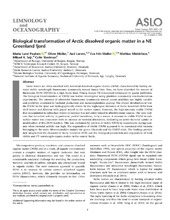| dc.contributor.author | Paulsen, Maria Lund | |
| dc.contributor.author | Müller, Oliver | |
| dc.contributor.author | Larsen, Aud | |
| dc.contributor.author | Møller, Eva Friis | |
| dc.contributor.author | Middelboe, Mathias | |
| dc.contributor.author | Sejr, Mikael Kristian | |
| dc.contributor.author | Stedmon, Colin A. | |
| dc.date.accessioned | 2019-01-24T14:09:31Z | |
| dc.date.available | 2019-01-24T14:09:31Z | |
| dc.date.issued | 2018-12-07 | |
| dc.identifier.issn | 0024-3590 | en_US |
| dc.identifier.uri | https://hdl.handle.net/1956/18992 | |
| dc.description.abstract | Arctic waters are often enriched with terrestrial dissolved organic matter (DOM) characterized by having elevated visible wavelength fluorescence (commonly termed humic-like). Here, we have identified the sources of fluorescent DOM (FDOM) in a high Arctic fjord (Young Sound, NE Greenland) influenced by glacial meltwater. The biological transformation of FDOM was further investigated using plankton community size-fractionation experiments. The intensity of ultraviolet fluorescence (commonly termed amino acid-like) was highly variable and positively correlated to bacterial production and mesozooplankton grazing. The overall distribution of visible FDOM in the fjord was hydrographically driven by the high-signal intrusion of Arctic terrestrial DOM from shelf waters and dilution with glacial runoff in the surface waters. However, the high-intensity visible FDOM that accumulated in subsurface waters in summer was not solely linked to allochthonous sources. Our data indicate that microbial activity, in particular, protist bacterivory, to be a source. A decrease in visible FDOM in subsurface waters was concurrent with an increase in bacterial abundance, indicating an active bacterial uptake or modification of this DOM fraction. This was confirmed by net-loss of visible FDOM in experiments during summer when bacterial activity was high. The degradation of visible FDOM appeared to be associated with bacteria belonging to the order Alteromonadales mainly the genus Glaciecola and the SAR92 clade. The findings provide new insight into the character of Arctic terrestrial DOM and the biological production and degradation of both visible and UV wavelength organic matter in the coastal Arctic. | en_US |
| dc.language.iso | eng | eng |
| dc.publisher | Wiley | en_US |
| dc.relation.ispartof | <a href="http://hdl.handle.net/1956/17362" target="blank"> Microbial dynamics in high latitude ecosystems. Responses to mixing, runoff and seasonal variation a rapidly changing environment</a> | en_US |
| dc.rights | Attribution CC BY | eng |
| dc.rights.uri | http://creativecommons.org/licenses/by/4.0/ | eng |
| dc.title | Biological transformation of Arctic dissolved organic matter in a NE Greenland fjord | en_US |
| dc.type | Peer reviewed | |
| dc.type | Journal article | |
| dc.description.version | publishedVersion | en_US |
| dc.rights.holder | Copyright 2018 The Authors | en_US |
| dc.identifier.doi | https://doi.org/10.1002/lno.11091 | |
| dc.identifier.cristin | 1654432 | |
| dc.source.journal | Limnology and Oceanography | |

